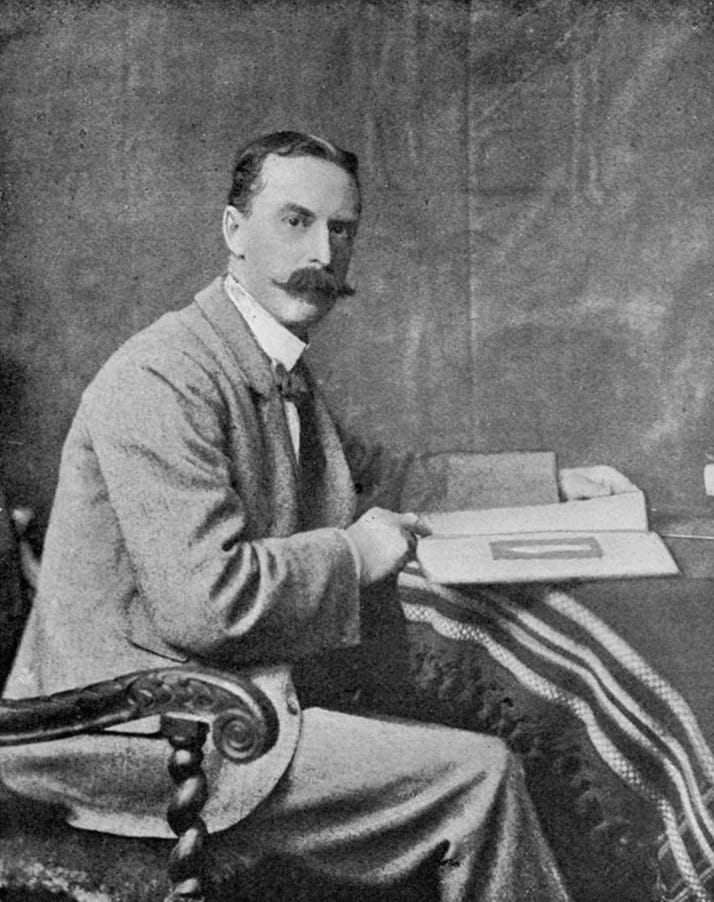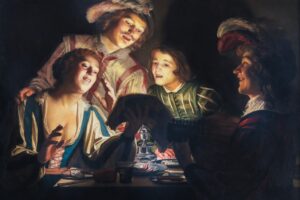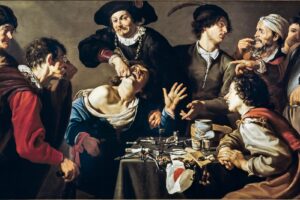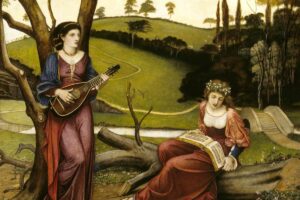Table of Contents
Overview
The King and the Beggar-maid (1898) by Edmund Blair Leighton captures a moment where humility and majesty meet. Based on a medieval ballad retold in Alfred Lord Tennyson’s poem The Beggar Maid, the painting depicts a barefoot maiden standing shyly as a king kneels before her, crown in hand.
Leighton, a Victorian painter known for his romanticized medieval and historical subjects, presents the story with theatrical grace and Pre-Raphaelite attention to detail. Rich draperies, glowing colors, and emotional intensity combine to create a tableau of devotion and destiny — the union of power with innocence, royalty with humility.
The Story Behind the Painting
From Ballad to Poem
The subject comes from the medieval legend of King Cophetua, who, despite his wealth and disdain for love, is struck by the beauty of a poor beggar maid. He declares his intent to marry her, lifting her from poverty to become his queen. Alfred Lord Tennyson’s 1833 poem The Beggar Maid revived the tale for Victorian audiences, presenting it as a parable of beauty, virtue, and humility rewarded.
Edmund Blair Leighton’s Vision
Edmund Blair Leighton (1852–1922) was not formally part of the Pre-Raphaelite Brotherhood, but his art carried their legacy into the late 19th century. Famous for romanticized medieval and chivalric themes (The Accolade, God Speed), Leighton combined historical romanticism with decorative splendor. In The King and the Beggar-maid, he distilled the legend into a moment of poignant encounter — a king kneeling in submission before pure beauty.
A Victorian Fascination
Victorian audiences were deeply drawn to tales of moral beauty overcoming worldly rank. To them, the beggar maid symbolized humility and virtue, while the king represented devotion elevated by love. The story mirrored ideals of purity, selflessness, and redemption through love — central values in 19th-century romantic art.
Composition and Subjects
The Beggar-maid
At the center stands the beggar-maid, barefoot and simply dressed in a pale tunic, her cloak falling loosely over her shoulders. She places her hand modestly on her chest, her face touched by both shyness and grace. Though clothed in rags, she glows with inner beauty, her presence as radiant as the gilded setting around her.
The King in Devotion
Kneeling before her is the king, his robe heavy with red and gold embroidery, crown in hand. His posture conveys humility, devotion, and reverence, as though acknowledging that true majesty lies not in wealth but in love. The gesture of offering the crown elevates the maiden beyond poverty into dignity, embodying the transformative power of love.
The Setting
The scene unfolds in a richly decorated hall, with golden pillars, embroidered curtains, and a patterned carpet underfoot. The architectural details — arches, carvings, and a glowing chandelier — evoke a medieval palace yet are imbued with Victorian opulence. The contrast between the maiden’s simplicity and the lavish environment intensifies the story’s moral core.
Onlookers in the Shadows
In the background, courtiers peer from the shadows, their expressions mixed with curiosity and disbelief. Their presence adds depth to the drama, reminding us that this is a public act, a defiance of rank and expectation. The king’s gesture is not private passion but a proclamation of love to the world.
Art Style and Techniques
Romantic Realism
Leighton’s style combines Pre-Raphaelite precision with late Victorian romanticism. The fabrics, metals, and surfaces are rendered with exquisite realism — every fold, gleam, and pattern painted with clarity. Yet the subject is heightened, almost theatrical, designed to stir emotion rather than document history.
Color and Light
The palette glows with contrast: the king’s deep crimson and gold against the maiden’s pale white and soft cloak. The warm tones of the draperies and golden pillars enhance the sense of splendor. Light falls gently on the maiden, casting her as the luminous center of the scene, the true jewel of the court.
Theatrical Composition
The composition is arranged like a stage play: the kneeling king in red, the maiden elevated on the step, and the backdrop of curtains framing the drama. This theatricality was central to Leighton’s success, appealing to Victorian audiences who loved narrative art filled with romance and moral weight.
Legacy and Reflection
A Romantic Favorite
The King and the Beggar-maid remains one of Blair Leighton’s most admired works, exemplifying his ability to merge narrative, symbolism, and spectacle. Though painted at the close of the Victorian era, it carries forward the ideals of the Pre-Raphaelites — beauty, morality, and storytelling through detail.
Enduring Meaning
The painting continues to resonate as a parable: love transcends status, humility triumphs over pride, and beauty shines not through wealth but through virtue. The barefoot maiden and the kneeling king embody a timeless truth — that love levels all ranks, crowning the heart above the throne.
She stands barefoot, hand to her chest, surrounded by gold and shadow. He kneels before her, crown outstretched, his robe heavy with jewels. In this moment, Edmund Blair Leighton captures a vision both medieval and eternal — the triumph of love, the crowning of humility.
About Artist

Edmund Blair Leighton ROI (September 21, 1852 – September 1, 1922) was an English painter best known for his historical genre scenes, especially those depicting medieval and Regency subjects. Born in London to artist Charles Blair Leighton, he initially worked in business before pursuing art classes at South Kensington and Heatherley’s Art School. Leighton later attended the Royal Academy Schools and established a successful career with annual exhibitions at the Royal Academy from 1878 to 1920.
Artist Style and Movement
Leighton belonged to the Pre-Raphaelite tradition and Victorian Romanticism, creating highly polished, finely detailed works that romanticize chivalry, loyalty, and medieval courtly life. His paintings often depict elegant ladies, knights, and scenes inspired by Shakespeare, Malory, and other historical and literary sources. He was admired for his fastidious technique and decorative, narrative-driven compositions. His work bridged the Pre-Raphaelite ideals with popular Victorian tastes.
Notable Works
- The King and the Beggar-maid (1898): One of Leighton’s most celebrated paintings, illustrating the medieval legend of King Cophetua falling in love with a beggar-maid, captured with rich detail and emotive storytelling.
- The Accolade (1901): Depicts a knight being knighted by a queen, embodying ideals of chivalry and honor.
- Godspeed (1900): Shows a romantic farewell scene with a knight riding into battle.
- Lady Godiva (1892): A historical and mythical subject showing the legendary ride of Lady Godiva.
- Tristram and Isolde (1907): A romantic medieval scene based on the famous legend.
- Two Strings (1893): A gentle genre work celebrating domestic tranquility.
- Launched in Life (1894): Depicts a young woman preparing for her social debut with elegance.
- To Arms (1888): A patriotic and martial subject painting.
- The Dying Copernicus (1880): A historical scene portraying the great astronomer’s final moments.
Edmund Blair Leighton’s artistic legacy centers on his masterful blending of historical romanticism and Victorian aesthetics. His detailed and polished works remain iconic representations of medieval lore and chivalric ideals. Leighton’s paintings influenced the visual language of medievalism in popular culture, and he remains remembered as one of the prominent British painters of his era.



